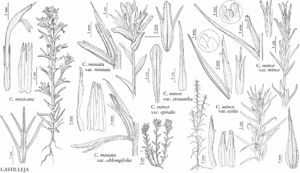Castilleja miniata var. miniata
Herbs 1.6–6.5 dm; with a taproot or with slender, branched roots from a rhizome. Stems glabrous or sparsely hairy proximally and medially, subglabrous or sparsely hairy distally, hairs spreading, short to long, soft, eglandular, rarely stipitate-glandular. Leaves spreading to ascending, linear to lanceolate, narrowly elliptic, or narrowly oblong, thin and not fleshy, margins plane, rarely wavy, flat to slightly involute, leaf sometimes recurved downward, 0(–3)-lobed, apex acute to acuminate, sometimes obtuse. Bracts distally scarlet, red, orange-red, or pale orange, sometimes pink, pink-purple, magenta, pale orange, yellow, greenish yellow, or white, 0–3(–5)-lobed, central lobe with 3–5 small teeth at apex; central lobe apex obtuse, rounded to truncate, lateral ones acute to rounded. Calyces 15–36 mm; abaxial and adaxial clefts 8–20 mm, ca. 40% of calyx length, subequal or abaxial longer, lateral 1–9 mm, 15–20% of calyx length; lobes narrowly lanceolate to narrowly triangular or linear, apex acute, sometimes acuminate or obtuse. Corollas 20–48 mm; beak 9–25 mm; abaxial lip deep green or deep purple, 0.5–3.5 mm, 10–15% as long as beak, to ca. 33% as long as beak in some populations. 2n = 24, 48, 72, 96, 120.
Phenology: Flowering Mar–Sep(–Oct).
Habitat: Moist or wet meadows, stream banks, shores, open forests, rocky slopes, roadsides, forest edges.
Elevation: 0–3700 m.
Distribution
Alta., B.C., Man., Ont., Sask., Alaska, Ariz., Calif., Colo., Idaho, Mont., Nev., N.Mex., Oreg., Utah, Wash., Wyo.
Discussion
Variety miniata is much more widespread than the other varieties of Castilleja miniata. Occasional hybrids are encountered between this variety and a wide range of species. Apparent hybrid swarms with C. rhexiifolia and/or C. septentrionalis are occasional in the Rocky Mountains. In the Pacific Northwest and across the prairie provinces of Canada, populations with relatively short inflorescences and pink bracts deserve further study. Likewise, populations of pink to pink-purple plants with shorter corollas and corolla beaks are found on boggy ground in the Peace River region of northwestern Alberta and adjacent British Columbia. A slightly rhizomatous form from the coast of British Columbia to southeastern Alaska was named C. hyetophila. The precise relationship of the rhizomatous form with var. dixonii and with C. miniata as a whole is still unclear and merits comprehensive study.
Selected References
None.
